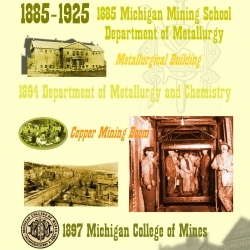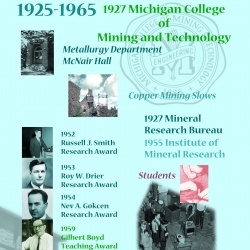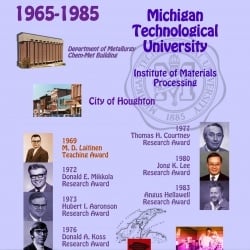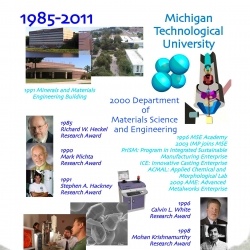1885-1925: Department of Metallurgy and Chemistry
Michigan Mining School and Michigan College of Mines
The Upper Peninsula of Michigan was home to one of the United States' great metal mining booms in the late 1800s. Starting around 1850, native copper metal was mined, and in the 1880s and 1890s the activities grew to truly massive proportions, fed by the nation's demand for electrical wiring and other copper metal products. As an example of the scale of the operations, in 1895 the Calumet and Hecla Mining Company, just one of the major producers, paid a dividend of $25 million to its shareholders. The nearby city of Calumet, Michigan, was one of the first cities in the world to install electric street lights and trolley cars.
To support the mining industry, the State of Michigan opened the Michigan Mining School in the fall of 1886, with facilities located in the upper story of the original Houghton Fire Hall. Metallurgy was an important component of the mining curriculum from the start, and a distinct department was established on the discipline; however, in 1894, the metallurgy and chemistry departments were combined.
In 1897, the school's name was changed to the Michigan College of Mines, and by 1904, the metallurgy department had once again become an independent entity and now occupied a new building, which burned in 1924 and was replaced by the original McNair Hall. For approximately forty-seven years, McNair Hall was home to the metallurgy department, until it was demolished to make way for construction of the Electrical Energy Resources Center. In 1973, the department moved into the Chemistry-Metallurgy Building, and in 1991, the department took up residence in the Minerals and Materials Building, the facility that houses the research and teaching operations today.
|
1660 |
Jesuit missionary explorer Father Rene Menard is first known European to reach Keweenaw Bay, wintering at site near what is now L’Anse. |
|
1836 |
In exchange for abandoning its claim on the commercially-active Toledo strip as part of a border dispute (known as the “Toledo War”) with the state of Ohio and as a condition for its approval of Michigan’s petition for statehood, the U.S. Congress proposes a compromise that will assign to Michigan most of the area now known as the Upper Peninsula. Under pressure from the Congress and President Andrew Jackson, Michigan concedes defeat in the border dispute and grudgingly approves the compromise in December at a meeting known as the “Frost-bitten Convention” of the territorial government. |
|
1837 |
Michigan becomes a state. |
|
1841 |
Douglass Houghton submits his first scientific report to the State detailing iron and copper resources in the Upper Peninsula. |
|
1845 |
Douglass Houghton drowns in Lake Superior near Eagle River, MI. |
|
1852 |
Portage Lake, the town that will eventually be renamed as Houghton, is established by Ransom Sheldon. |
|
1861 |
A bill is unsuccessfully introduced in Michigan Legislature to provide “a mining school in Houghton, in the County of Houghton.” |
|
|
The first widespread usage of copper and brass, largely for rifle shells in Civil War, stimulates a large national demand for copper. |
|
1865 |
US Congress authorizes excavation to create the Portage Lake shipping canal. Houghton becomes a primary shipping port for the Keweenaw mining district. |
|
1885 |
“The Michigan Mining School” is established from “Act 70” of the Michigan Legislature, sponsored by the Honorable Jay A. Hubbell, State Senator from Lake Linden. |
|
1886 |
Albert S. Williams was named “Principal” of the Michigan Mining School with an initial faculty of three. |
|
|
23 students enroll in the first session of the new school. |
|
|
First Classes held on the second floor and basement of the Houghton Fire House until 1889. |
|
|
“Ore Dressing” established as the first course in the mining sub-discipline known as “Metallurgy.” |
|
1887 |
Marshman Edward Wadsworth was elected “Director” or “Chief Executive” of the new school. |
|
|
The Mining School expands to occupy 4 rented rooms in nearby Odd Fellows Building (aka Hartman Building; later Central Foods and presently Statewide Realty). |
|
|
A faculty is established for instruction in the defined areas of 1.) geology and mining, 2.) mathematics and drawing, 3.) chemistry; 4.) mineralogy, petrography, and geology; and 5.) mining and engineering. |
|
1888 |
Fred Fraley Sharpless, S.B., joins the faculty as Instructor of Chemistry and Metallurgy. |
|
|
The first graduating class (2-year program) of 7 men occurs; included among the graduates was Edmund Longyear, who later developed diamond drilling which enabled the first extensive exploration of the Mesabi Iron Range of Minnesota. Longyear was later inducted in the International Mining Hall of Fame. |
|
1889 |
The Mining School moves to “Science Hall”, later renamed Hubbell Hall, on a site east of Houghton on land partially donated by Senator Hubbell. |
|
|
First “Engineer of Mines” (E.M.) degrees (3 year course) were awarded to 6 men. |
|
|
Dr. Marshman Wadsworth is named President of the School. |
|
1890 |
The Board of Control of the Mining School establishes free tuition for both in- and out of-state students, 1890-92. |
|
|
The total copper production in Lake Superior mining district to date reaches 1,764,526,539 pounds (882,263 tons). |
|
1891 |
Fred Fraley Sharpless is given the title, “Professor of Metallurgy.” |
|
1892 |
Metallurgical assay lab added to Hubbell Hall. |
|
1893 |
|
|
1894 |
Metallurgy and Chemistry are packaged as the first stand-alone department within the College. |
|
1895 |
Arthur Edmund Seaman, S.B., is named Assistant Professor of Mineralogy and Geology. |
|
|
George Augustus Koenig, M.E., A.M., Ph.D., is named Professor of Chemistry and Metallurgy. |
|
1896 |
|
|
1897 |
School name changed to the Michigan College of Mines. |
|
1898 |
James Fisher Jr., E.M. joins as Instructor of Mathematics and Physics. |
|
|
Dr. Fred Walter McNair named President of the School. |
|
|
“Old” metallurgical and assay laboratories established and opened. |
|
1899 |
Fred Walter McNair is named President of Michigan College of Mines. |
|
1900 |
|
|
1901 |
Engineering (later Sperr) Hall is completed with state funding. |
|
1902 |
|
|
1903 |
|
|
1904 |
Metallurgy building completed. |
|
|
Metallurgy becomes a stand-alone department within MCM. |
|
1905 |
|
|
1906 |
|
|
1907 |
|
|
1908 |
College enrollment reaches a maximum of 292 students, but is followed by several years of decline due to economic recession and widespread suspicion of mining due to over-speculation. |
|
1910 |
|
|
1911 |
|
|
1912 |
|
|
1913 |
|
|
1914 |
Professor A.J. Houle named head of Department of Metallurgy. |
|
1915 |
|
|
1916 |
|
|
1917 |
|
|
1918 |
|
|
1919 |
Harry Benedict, Chief Metallurgist for the Calumet and Hecla Mining Company, joins MCM as Lecturer of Metallurgy. |
|
|
James MacNaughton, General Manager of the Calumet and Hecla Mining Company and eventual donor of the collegiate hockey trophy that bears his name (currently awarded to the regular season champion of the Western Collegiate Hockey Association), is named Special Lecturer of Metallurgy. |
|
1920 |
First MCM Hockey team formed by Endicott Lovell. |
|
|
First intercollegiate football at the College. |
|
1921 |
|
|
1922 |
“The Lode” College newspaper established. |
|
1923 |
Metallurgy Building burns down. |
|
1924 |
Dr. Fred McNair, college president, is killed in a train accident. |
|
|
First Issue of the Keweenawan yearbook is published |
|
1925 |
William Otis Hotchkiss becomes President of Michigan College of Mines. |
|
|
Roy Ward Drier joins Metallurgy faculty as Assistant in Metallurgy. |
|
|
McNair Hall, constructed as a fire-proof building, is completed and becomes the new home of the Metallurgy Department. |
|
|
Degree name is changed to Metallurgical Engineering. |
1925-1965: Department of Metallurgy
Michigan College of Mining and Technology
In the mid-1920s, the Great Depression reduced the demand for mining engineers, and the Michigan College of Mines began to consider diversifying its curriculum to attract a larger student body. After considerable controversy, the Michigan State Legislature and the governor first broadened the scope of the college's charter to permit three-year degrees in metallurgy and mining, and two-year degrees in several other engineering disciplines. In 1927, the state again changed the name of the college, this time to the Michigan College of Mining and Technology, from which the moniker "Michigan Tech" was coined. With this change in name, Michigan Tech further broadened the scope of its educational offerings, with the addition of four-year undergraduate programs, graduate programs at the master's level, and the authorization to conduct research. By the mid-1930s, Michigan Tech was authorized to grant PhD degrees, and in 1934, metallurgy faculty members Corbin Eddy and Roy Drier received the first two PhD degrees awarded by the college.
|
1926 |
First M.S. degrees established in Metallurgy, Chemistry, Geology, and Mechanical Engineering. |
|
1927 |
College name changes to Michigan College of Mining and Technology (MCMT). |
|
|
The first M.S. degrees at MCMT are awarded to Corbin Eddy and Jack L. Byers, in Metallurgy. |
|
|
Corbin T. Eddy, B.S., E.M., M.S. and Jack L. Byers B.S. M.S., joins as Instructors of Metallurgy. |
|
1928 |
|
|
1929 |
|
|
1930 |
|
|
1931 |
88 Enrolled in the Metallurgy Department . |
|
1932 |
PhD degree in Metallurgy is established. |
|
|
The alpha chapter of Alpha Sigma Mu (ASMu) is formed by students and faculty of the Metallurgy department at MCMT. |
|
1933 |
first degree awarded to a female student at MCMT. |
|
1934 |
First PhD’s granted by MCMT are awarded to Corbin T. Eddy and Roy Drier, both faculty in the Metallurgy Department. |
|
|
The MCMT student chapter of ASM is formed. |
|
1935 |
50 year anniversary of the university. |
|
|
Grover C. Dillman becomes president of MCMT. |
|
1936 |
The first meeting of the student chapter of ASM at MCMT is held. |
|
1937 |
|
|
1938 |
Gilbert Wing Boyd joins the university as Assistant Professor of Metallurgy. |
|
|
Douglass Houghton Hall completed. |
|
|
First Michigan Tech Olympian is selected; Eddie Maki, in hockey. |
|
1939 |
|
|
1940 |
Corbin Eddy is appointed as Head of Metallurgical Engineering. |
|
1941 |
|
|
1942 |
|
|
1943 |
Dee Stadium given to MTU by James R. Dee. |
|
1944 |
|
|
1945 |
|
|
1946 |
M.S. degree name changes to Metallurgical Engineering. |
|
1947 |
Lilian Beck is first female BS recipient in Metallurgy / Metallurgical Engineering. |
|
1948 |
|
|
1949 |
|
|
1950 |
|
|
1951 |
|
|
1952 |
|
|
1953 |
Dr. Roy W. Drier helps to establish M.C.M.&T. Foundation. |
|
1954 |
|
|
1955 |
Ores Research Building is completed. |
|
|
Institute of Minerals Research (IMR) is founded. |
|
1956 |
J.R. VanPelt is elected president of MCMT. |
|
1957 |
|
|
1958 |
|
|
1959 |
Raymond Smith is appointed head of Metallurgical Engineering Department (1959-64). |
|
1960 |
|
|
1961 |
|
|
1962 |
|
|
1963 |
PhD degree name changes from Metallurgy to Metallurgical Engineering. |
|
1964 |
College becomes Michigan Technological University on January 1. |
|
1965 |
Raymond Lloyd Smith become President of MTU (1965-‘79). |
1965-1985: Department of Metallurgy
Michigan Technological University
With the final decline of the local copper mining industry in the 1960s, the college began adding programs to the curriculum in diverse areas of study. In 1964, the name Michigan Technological University was officially adopted.
Since its inception in the late 1800s, our undergraduate program evolved from mineral dressing to metallurgy, to metallurgical engineering, to metallurgical and materials engineering. In July 2000, we became known as the Department of Materials Science and Engineering. The name change was made to better reflect the breadth of instructional and research activities in which our students and faculty are engaged. Our new name is also consistent with our sister departments in other institutions, including many that started out as "metallurgy" or "mineral dressing" departments.
|
1966 |
|
|
1967 |
Metallurgical Engineering Department becomes largest in the United States. |
|
1968 |
|
|
1969 |
Metallurgy Department gets $100,000 grant per year from NSF for Ph.D. program. R.W. Guard becomes Department Head. |
|
1970 |
Physical Metallurgy concentration option is added to curriculum. |
|
|
Nancy Scofield is the first female to receive a PhD at Michigan Tech, in Geology, conducting research in the area of mineral chemistry. |
|
1971 |
Dale Stein is appointed head of Metallurgical Engineering Department (1971-’77). |
|
1972 |
Original McNair Hall is demolished to make room for the EERC; Metallurgical Engineering Department moves to the newly completed Chemistry-Metallurgy (Chem-Met) Building. |
|
|
First SEM purchased by the Metallurgy Department. |
|
1973 |
|
|
1974 |
Dale Stein assumes the additional role as Head of Mining Engineering Department |
|
(1974-’77). |
|
|
1975 |
|
|
1976 |
|
|
1977 |
Dale Stein is named Academic Vice President (1977-’79). |
|
1978 |
Lloyd A. Heldt is appointed Head of Metallurgical Engineering Department (1978-’92). |
|
1979 |
Dale Stein is named President of MTU (1979-’91). |
|
1980 |
Metallurgical Engineering department sets all time undergraduate enrollment maximum at 310 students, a number that constitutes approximately 10% of all metallurgical engineering students nationwide at that time. |
|
1981 |
|
|
1982 |
|
|
1983 |
|
|
1984 |
|
|
1985 |
Dr. Stein is elected to U.S. National Academy of Engineering. |
|
1986 |
|
1985-Present: Department of Materials Science and Engineering
Michigan Technological University
The present scopes of our undergraduate program, including both instructional and research programs, encompass broad multidisciplinary approaches to the beneficiation, refining, processing, development, application, and recycling of engineering and engineered materials. We are extraordinarily proud of our graduates, many of whom have achieved national recognition in our profession and as entrepreneurs, researchers, and administrators.
|
1987 |
Jean Kampe is the first female to receive a PhD in the Metallurgical Engineering Department. |
|
1988 |
Institute of Minerals Research (IMR) expands its focus and becomes the Institute of Materials Processing (IMP). |
|
|
Michigan’s Copper Country named as an ASM Historical Landmark. |
|
1989 |
|
|
1990 |
Department changes its name from Metallurgical Engineering to Metallurgical and Materials Engineering (MME). |
|
1991 |
Minerals and Materials Building opens; Metallurgical and Materials Engineering Department relocates. |
|
|
Curtis J. Tompkins becomes President of MTU. |
|
1992 |
|
|
1993 |
Thomas H Courtney is named Chair of MSE (’93-’96). |
|
1994 |
|
|
1995 |
|
|
1996 |
Degree names are changed from BS and MS in Metallurgical Engineering to BS and MS in Metallurgical and Materials Engineering. |
|
|
Calvin White is named Chair of MSE (1996-2003). |
|
1997 |
|
|
1998 |
|
|
1999 |
|
|
2000 |
Department name changes to Materials Science and Engineering (MSE). |
|
|
BS, MS, and PhD degree names change to Materials Science and Engineering (MSE). |
|
2001 |
Mineral Processing option/concentration phased out of MSE and moved to Chemical Engineering as a concentration. |
|
2002 |
Mineral Process Engineering Option formally eliminated by the MTU Senate and BOC. |
|
2003 |
Mark R. Plichta is named Chair of MSE (2003-‘12). |
|
2004 |
BS in Mining Engineering suspended by MTU Senate and BOC. |
|
|
Glenn D. Mroz becomes the 9th President of Michigan Tech. |
|
2005 |
|
|
2006 |
|
|
2007 |
|
|
2008 |
|
|
2009 |
|
|
2010 |
|
|
2011 |
|
|
2012 |
|
|
2013 |
MSE Course-only (non-thesis) MS degree approved by MSE faculty. First class of 6 course-only MS students admitted for Fall 2014 semester. |
|
2014 |
|
|
2015 |
|




